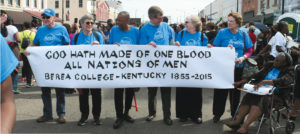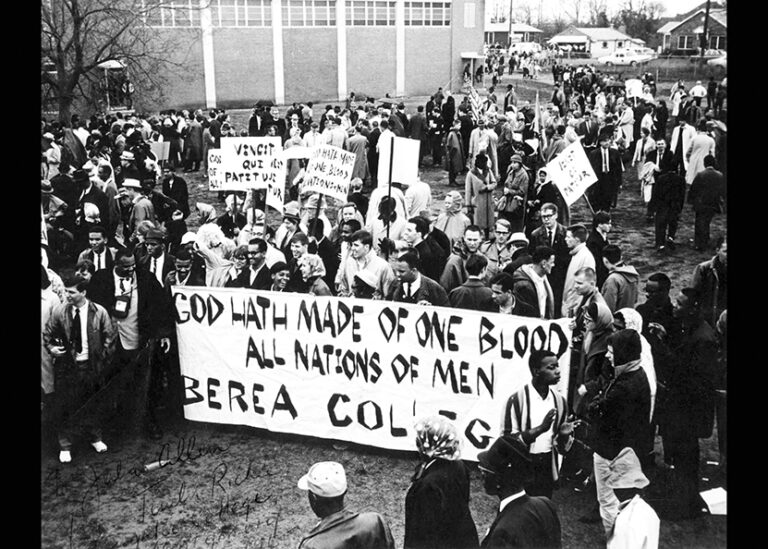“God has made of one blood all peoples of the earth. (Acts 17:26)”
That ringing claim, part of Paul’s great sermon to the Athenians included in Acts chapter 17, has always been foundational to the mission and identity of Berea College.
Rev. John G. Fee’s intent was to provide education to young men and women regardless of race, and the scope of the institution he created was regional by necessity. After all, in 1860, the young men and women from other parts of the country were not very likely to travel to Kentucky for their education. Berea College has remained steadfast with Rev. Fee’s intention over time, and those essential elements of our mission are now captured through Berea’s First, Fifth, and Eighth Great Commitments: to provide an educational opportunity primarily for students from Appalachia, black and white, who have great promise and limited economic resources; to assert the kinship of all people and to provide interracial education with a particular emphasis on understanding and equality among blacks and whites; and to serve the Appalachian region primarily through education but also by other appropriate services.
The Great Commitments provide lenses through which we continually examine ourselves to be sure we really understand and fulfill our aspirations, taking into account current cultural, regional, and educational circumstances. Our recent initiative called Exploring the Commitments, which has been discussed in prior issues of the Berea Magazine, has looked anew at how we can best continue to serve the populations of Appalachia and how we might extend our concept of interracial education and community in our learning, working, and living environments. We continue to believe that our foundation of engaging in the conversation of “black and white” serves as a gateway to all other forms of diversity at the College, an integrated and interracial learning community aspiring to “impartial love,” where students can live and study together and learn from and about each other.
“Interracial education” is an interesting phrase, and I have thought hard about it. To me, it has to mean more than an education of students of different races in the same school. And it has to mean more even than persons of different races inhabiting the same place together, although that in itself is a wonderful thing, too. The key is that because of this foundational commitment, Berea is neither a white Appalachian institution that welcomes students of color, nor is it an historically black institution that welcomes white students. From our founding, we have sought to be an interracial community and school, although the Commonwealth of Kentucky prohibited that through the Day Law from 1904-1954.

I want to highlight a few other important points about the Fifth and Eighth Great Commitments. First, interracial education has to be bound up in confronting injustice together. Too often our black students have had personal experiences of racism and prejudice, and white students from Appalachia are not necessarily strangers to prejudice either. An interracial community learns about and confronts these ugly cultural elements; persons of every race and regional origin standing together, shoulder-to-shoulder.
Second, one cannot effectively confront that which one does not fully understand. That is where the academic dimension of the College becomes so important—the Carter G. Woodson Center for Interracial Education, the Black Cultural Center, the Hispanic Outreach Program, the Hispanic Student Association, the Loyal Jones Appalachian Center, and other centers and programs on campus all help make us a “learning community” around these complex issues. We need full and dynamic understandings of the workings of prejudice, privilege, and the constructions of race and identity through communication, collaboration, service to others, and education at Berea. These intersections play out at all levels, individually, locally, and nationally. So discovery, knowledge, and sharing are essential.
In March of 1965, during a time of protest and civil disobedience centered on voting rights in the South, 58 Berea students and faculty, whites and blacks, answered the clarion call of Dr. Martin Luther King, Jr. to join the march from Selma to Montgomery after Bloody Sunday’s events played out tragically on televisions across the country. Our students marched proudly (and, as they have recently told us, also with great fear for their personal safety), carrying a banner that proclaimed the motto with which I started this column, expressed in the translation we used at that time, “God hath made of one blood all nations of men.”
Recently, we had a wonderful opportunity to renew tangibly our commitment to justice and equality, as our nation celebrated the 50th anniversary of this march across Selma’s Edmund Pettus Bridge. Organized by Dr. Alicestyne Turley, director of our Carter G. Woodson Center, a bus from Berea College made that trip to Selma again, carrying current students, twelve alumni participants from the 1965 march, and faculty and staff members. I was privileged to be part of this group. Again we carried a banner and again we marched, this time in the joyous company of tens of thousands of fellow citizens, all committed to continuing progress in the struggle for equal rights and opportunity and for a nation that aspires to the same inclusivity that characterizes the aspirations of our College.
Today we realize that racial justice in our country has become more multi-hued, and so we are broadening our efforts to serve and incorporate into our community “all peoples of the earth. (Acts 17:26)” For many decades now, we have welcomed people who come originally from the countries of Asia, and our community has been greatly enriched through their presence and the addition of our vibrant Asian Studies program. We have welcomed many African students as well. More recently, we have begun to focus on the underserved Hispanic populations of Appalachia, the demographic that is undergoing the most rapid growth in the region. Again, the inclusion of this population has resulted in wonderful enhancements to our community, including some memorable presidential experiences.
All along that march over the Edmund Pettus Bridge, people said to us, “Berea College, I know about you, what a great place!” A reporter from USA Today noticed us, which led to interviews and videotaping that can be seen on its website. It is so rewarding and fulfilling to be at an institution with a commitment to interracial education and inclusivity, and it makes us a profoundly better school and community.


